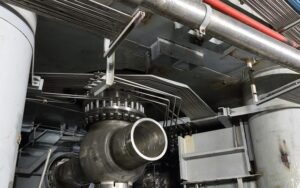Industrial air doors are high-performance barriers that significantly enhance energy efficiency in warehouses and factories by preventing conditioned air loss, reducing HVAC loads, and minimizing energy costs—especially during extreme weather. These game-changing door systems, including heavy-duty air curtains and large opening air valves, are essential components of modern manufacturing units, contributing to sustainable and cost-effective operations. Strategically implementing them at loading docks, factory entrances, and cold storage facilities can lead to substantial energy savings without compromising safety or operational needs.
Industrial air doors are transforming the way we approach energy efficiency in heating, ventilation, and air conditioning (HVAC) systems. This cutting-edge technology offers a simple yet powerful solution to reduce energy consumption and lower operational costs. By understanding how these doors work and their significant benefits, businesses can contribute to sustainability while optimizing HVAC performance. This article explores the impact of energy-saving industrial air doors on energy-intensive industries and provides strategies for successful implementation.
- Understanding Industrial Air Doors: How They Work and Their Benefits
- The Impact of Energy-Efficient Solutions on HVAC Systems
- Implementing Industrial Air Doors: Strategies for Optimal Results
Understanding Industrial Air Doors: How They Work and Their Benefits

Industrial air doors are innovative solutions designed to enhance energy efficiency in various industrial settings. These doors serve as advanced entrance barriers, providing effective warehouse opening protection and factory entrance solutions. By acting as a robust industrial climate separation, they regulate indoor temperatures and reduce the workload on heating, ventilation, and air conditioning (HVAC) systems.
The mechanism behind their effectiveness lies in their ability to create a seal at large openings, such as those found in warehouses, factories, and loading docks. These heavy-duty air doors operate like air curtains, preventing warm or cold air from escaping and keeping out unwanted elements. This simple yet powerful action significantly minimizes energy loss, making them essential components of modern manufacturing door systems. Compared to traditional doors, cold storage air doors and large opening air curtains offer superior insulation, resulting in considerable savings on energy costs, especially in extreme weather conditions.
The Impact of Energy-Efficient Solutions on HVAC Systems

In today’s world, where energy costs are a significant concern for industries, adopting energy-efficient solutions can significantly reduce the workload on HVAC (Heating, Ventilation, and Air Conditioning) systems. Industrial air doors, such as heavy-duty air curtains and large opening air valves, are emerging as game-changers in this domain. These innovative manufacturing door systems serve as effective industrial entrance barriers, providing robust warehouse opening protection while minimizing energy loss. By acting as a barrier against temperature differentials, these advanced solutions prevent the escape of conditioned air, thereby decreasing the overall energy consumption and carbon footprint of facilities.
This shift towards energy-saving technologies is particularly crucial in factories and storage areas where maintaining optimal temperatures is essential. For instance, cold storage air doors and loading dock barriers can effectively separate industrial climates while ensuring efficient operations. By reducing the need for constant HVAC operation, these doors contribute to a more sustainable and cost-effective operational model. Consequently, they are becoming indispensable components of factory entrance solutions, catering to the diverse needs of modern manufacturing units across various sectors.
Implementing Industrial Air Doors: Strategies for Optimal Results

Implementing industrial air doors can significantly reduce energy consumption and improve HVAC efficiency in various industrial settings. To achieve optimal results, strategic placement is key. Identify areas where large openings are common, such as warehouse loading docks, factory entrances, or cold storage facilities, and prioritize these locations for installation. These heavy-duty air doors act as robust industrial entrance barriers, effectively sealing off spaces to prevent energy loss.
Consider the specific requirements of each site. For instance, manufacturing door systems need to withstand frequent opening and closing while providing excellent insulation. Warehouse opening protection requires durable materials that can handle constant use. Factory entrance solutions should also incorporate features like automatic operation for enhanced safety and efficiency. By selecting the right industrial air doors and strategically integrating them into existing infrastructure, businesses can achieve substantial energy savings without compromising on operational needs.
Industrial air doors are a game-changer in the quest for energy efficiency, especially within HVAC systems. By understanding their unique mechanisms and implementing strategic placement, these doors significantly reduce energy consumption, providing a sustainable solution for facilities management. This cost-effective approach not only minimizes the workload on HVAC units but also contributes to a greener environment. Embracing industrial air doors is a smart step towards a more sustainable future, where energy savings and optimal comfort go hand in hand.






